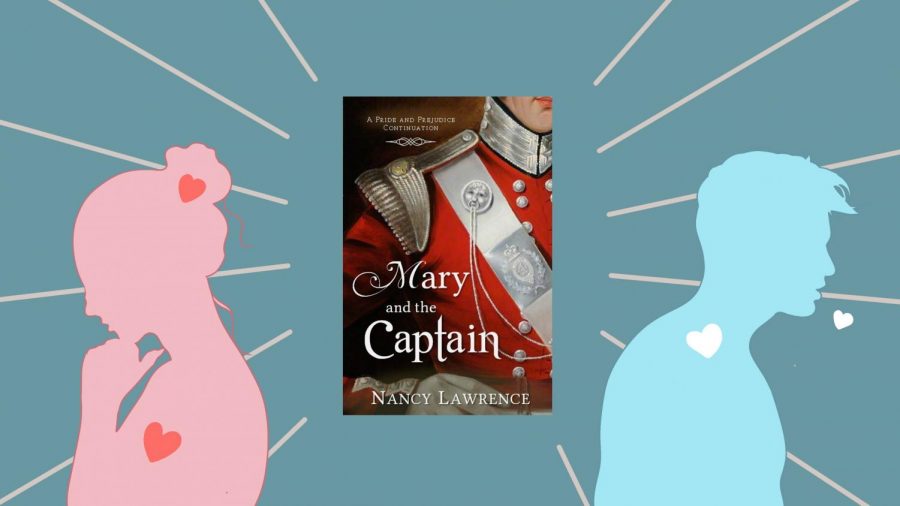Book Review: Mary and the Captain
Austen’s “Mary, Mary, Quite Contrary” Gets Her Own Voice — And Romance
August 21, 2021
As websites like Fanfiction.net and Wattpad.com swell in popularity for readers’ creative reimaginings of romantic pairings in books and films, professional authors have also begun to turn their literary eyes to rewriting the classics of centuries past. Nancy Lawrence is one such author. In a fresh novel said to be a “continuation” of Pride and Prejudice, she chooses the Bennet family’s long overlooked middle child, Mary Bennet, as her unlikely heroine.
Mary Bennet, plain, awkward, and decidedly not rich, with four stunning sisters and a nagging marriage-obsessed mother, seemed to always conveniently blend into the background of any social outing. But the self-professed “dull and unremarkable” Mary is to be struck by Cupid’s arrow in Lawrence’s Mary and the Captain, a feel-good satisfactory novel brimming with unlikely romance, unexpected redemption, and, of course, unfavourable first impressions.
It’s two weeks until Christmas and Mary Bennet is desperate for some peace and quiet. A quiet family reunion at Netherfield with Jane and Bingley seems just the ticket, but Bingley’s cunning sister Caroline has something far different in mind. Her brother Captain Robert is smitten with her dear friend Helena Paget – a beauty and lady and heiress, oh my! – and what better way to bring the two together than have them settled in Netherfield for Christmas under her watchful eye?
Robert arrives at Netherfield intent on wooing the lovely Helena, but nothing is to go as planned. As Miss Paget’s true and decidedly less attractive personality masks her outward beauty, Robert becomes more intrigued by shy, awkward Mary Bennet.
His evolving perception of Mary mirrors that of the reader, as Lawrence’s firm steering of events and the plot allows the reader to gradually gain a much more favourable impression of Mary than Austen’s meager rendering in the original. Though romance is indeed a significant motif of Lawrence’s composition, Mary’s personal character development is the true melody that sings out in the end.
Having always been more of a self-effacing introvert, compounded by being “the only plain one in the family,” it’s easy to see why Mary doesn’t offer many agreeable first impressions. Yet her awkwardness, which, in Pride and Prejudice, had been a subject of subtle mockery, becomes a means of relatability with the reader.
Sure, she does bust out a pedantic line or two from the admittedly mundane Sermons for Young Ladies, Volume One when particularly desperate, but her efforts and attempts to be more socially aware gives her an unwaveringly sincere voice that is not at all conceited and instead endears her shy, bookish nature to the reader.
As much as Mary’s journey to find her own voice was engrossing, Lawrence may have bitten off more than she could chew by wedging in a secondary redemption arc for Caroline Bingley, the master manipulator herself. Though Caroline certainly had the potential to become an absorbing heroine, Lawrence resorts to the now popular “Disney villain” treatment, concocting a tragic backstory that attempts to make up for all the character’s past offences. Caroline’s blossoming romance with a kind vicar is also peppered sporadically throughout the story and is admittingly sweet, but its overall ambiguity and vague resolution makes it fall flat satisfaction-wise.
Nonetheless, fans of Austen’s Pride and Prejudice will no doubt find Lawrence’s infatuated lovers just as compelling as the original couple. While Elizabeth and Darcy’s clear chemistry despite, or rather, because of, their contrasting personalities designated them as one of literature’s most popular “ships,” Mary and Robert’s romance is absorbing not because they seemed destined to be together, but because they appeared not. Their love flickers with the tender passion of patience and trust, burning steadily to a satisfying, albeit abrupt, ending where our “Mary, Mary, quite contrary” will finally, finally, get the man she deserves.





